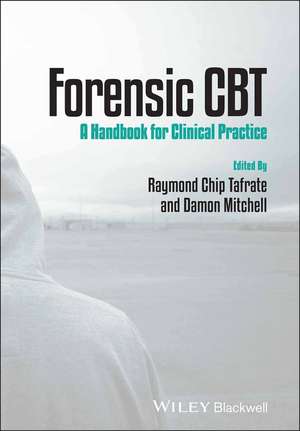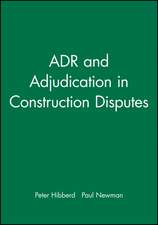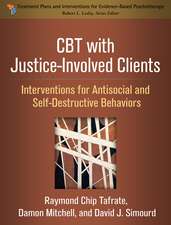Forensic CBT – A Handbook for Clinical Practice
Autor RC Tafrateen Limba Engleză Paperback – 31 oct 2013
- Features contributions from leaders of the major schools of CBT on the treatment of antisocial personality patterns as well as anger, interpersonal violence, substance abuse, and sexual aggression
- Addresses modified CBT approaches for female, juvenile, and culturally diverse forensic populations
- Covers emerging areas of forensic practices, including the integration of motivational interviewing and strength–based approaches
- Includes an assortment of worksheets, handouts, and exercises for practitioners to use with their clients
Preț: 354.15 lei
Nou
67.77€ • 73.59$ • 56.93£
Carte disponibilă
Livrare economică 01-15 aprilie
Livrare express 15-21 martie pentru 49.50 lei
Specificații
ISBN-10: 1119953286
Pagini: 520
Dimensiuni: 170 x 244 x 28 mm
Greutate: 0.78 kg
Ediția:New.
Editura: Wiley
Locul publicării:Chichester, United Kingdom
Public țintă
Primarily for behavioral health providers: including psychologists, social workers, counselors, marriage and family therapists, case managers, and community supervision officers working with justice–involved clients; also for graduate level students for courses in psychology, social work, criminal justice, and related disciplinesDescriere
With the current correctional population in the United States approaching 2 million and a probation population of more than 5 million there is an increasing demand for effective behavioral and emotional health services from forensic practitioners. Forensic CBT: A Handbook for Clinical Practice represents the first authoritative resource on the utilization of Cognitive–Behavioral Therapy (CBT) strategies and techniques for a wide variety of offender clients.
Contributions from leading experts in the major schools of CBT offer practical guidance on the treatment of antisocial personality patterns, anger, interpersonal violence, substance abuse, and sexual aggression. This practical guidance is supplemented by an assortment of worksheets, handouts, and exercises for practitioners to use with their clients. Coverage is also included on the use of modified CBT strategies for female, juvenile, and culturally diverse forensic populations; as well as emerging areas of forensic practices. Forensic treatment is presented from a wide spectrum of CBT approaches including Beck and Ellis, Acceptance and Commitment Therapy, Schema Focused Therapy, and criminal thinking models. Forensic CBT is an invaluable resource for practitioners working with juvenile and adult offenders in various criminal justice settings, both within institutions and in the community.
Textul de pe ultima copertă
With the current correctional population in the United States approaching 2 million and a probation population of more than 5 million there is an increasing demand for effective behavioral and emotional health services from forensic practitioners. Forensic CBT: A Handbook for Clinical Practice represents the first authoritative resource on the utilization of Cognitive–Behavioral Therapy (CBT) strategies and techniques for a wide variety of offender clients.
Contributions from leading experts in the major schools of CBT offer practical guidance on the treatment of antisocial personality patterns, anger, interpersonal violence, substance abuse, and sexual aggression. This practical guidance is supplemented by an assortment of worksheets, handouts, and exercises for practitioners to use with their clients. Coverage is also included on the use of modified CBT strategies for female, juvenile, and culturally diverse forensic populations; as well as emerging areas of forensic practices. Forensic treatment is presented from a wide spectrum of CBT approaches including Beck and Ellis, Acceptance and Commitment Therapy, Schema Focused Therapy, and criminal thinking models. Forensic CBT is an invaluable resource for practitioners working with juvenile and adult offenders in various criminal justice settings, both within institutions and in the community.
Cuprins
Contributors x
About the Editors and Contributors xiii
Preface xxi
1 Introduction: Critical Issues and Challenges Facing Forensic CBT Practitioners 1
Damon Mitchell, David J. Simourd, and Raymond Chip Tafrate
Part I Criminal Behavior and Antisocial Patterns: Conceptualizing Treatment from Different CBT Perspectives 11
Section 1 Traditional and Next Generation CBT Models 13
2 Traditional Cognitive–Behavioral Therapy Models for Antisocial Patterns 15
Lori Seeler, Arthur Freeman, Raymond DiGiuseppe, and Damon Mitchell
3 ACT for the Incarcerated 43
Jai Amrod and Steven C. Hayes
4 Schema Therapy for Aggressive Offenders with Personality Disorders 66
Marije Keulen–de Vos, David P. Bernstein, and Arnoud Arntz
Section 2 Criminal Thinking Models 85
5 An Overview of Strategies for the Assessment and Treatment of Criminal Thinking 87
Daryl G. Kroner and Robert D. Morgan
6 Applying CBT to the Criminal Thought Process 104
Glenn D. Walters
7 Training Community Corrections Officers in Cognitive–Behavioral Intervention Strategies 122
Tanya Rugge and James Bonta
Part II CBT Interventions for Common Criminal Justice Problem Areas 137
Section 1 Two Perspectives on the Treatment of Anger 139
8 Anger Management for Offenders: A Flexible CBT Approach 141
Howard Kassinove and Michael J. Toohey
9 Contextual Anger Regulation Therapy (CART): An Acceptance–Based Treatment for Domestic and Non–Domestic Violent Offenders 161
Frank L. Gardner and Zella E. Moore
Section 2 Two Perspectives on the Treatment of Intimate Partner Violence 185
10 CBT for Perpetrators of Intimate Partner Violence: The I3 Approach 187
Christopher I. Eckhardt, Cory A. Crane, and Joel G. Sprunger
11 A Couples–Based Violence Reduction Approach to Curbing Intimate Partner Assault 211
George F. Ronan, Kimberly Maurelli, and Krista M. Holman
Section 3 Two Perspectives on the Treatment of Addictions 231
12 An Integrated REBT–Based Approach to the Treatment of Addicted Offenders 233
F. Michler Bishop
13 Social and Community Responsibility Therapy (SCRT): A Cognitive– Behavioral Model for the Treatment of Substance–Abusing Judicial Clients 252
Kenneth W. Wanberg and Harvey B. Milkman
Section 4 Two Perspectives on the Treatment of Sexual Aggression 279
14 Balancing Clients Strengths and Deficits in Sexual Offender Treatment: The Rockwood Treatment Approach 281
William L. Marshall and Matt D. O Brien
15 Recidivism Risk Reduction Therapy (3RT): Cognitive–Behavioral Approaches to Treating Sexual Offense Behavior 302
Jennifer Wheeler and Christmas Covell
Part III Tailoring CBT to Special Forensic Populations 327
16 Advancing the Use of CBT with Justice–Involved Women 329
Marilyn Van Dieten and Erica King
17 CBT with Juvenile Offenders: A Review and Recommendations for Practice 354
Eva Feindler and Alison M. Byers
18 Culturally Responsive CBT in Forensic Settings 377
Andrew Day
Part IV Emerging Ideas for Practice 391
19 Session–by–Session Assessment of Client Participation and Progress 393
David J. Simourd
20 Integrating Motivational Interviewing with Forensic CBT: Promoting Treatment Engagement and Behavior Change with Justice–Involved Clients 411
Raymond Chip Tafrate and Jennifer D. Luther
21 Integrating Strength–Based Practice with Forensic CBT: The Good Lives Model of Offender Rehabilitation 436
Clare–Ann Fortune and Tony Ward
22 Treating Depression and PTSD Behind Bars: An Interaction Schemas Approach 456
Key Sun
Part V Conclusions 471
23 Forensic CBT: Five Recommendations for Clinical Practice and Five Topics in Need of More Attention 473
Raymond Chip Tafrate, Damon Mitchell, and Raymond W. Novaco
Index
Recenzii
"This book should be considered a must read for anyone who works anywhere in the corrections system, (local, state, and/or federal). Whether you are working with pretrial incarcerated offenders in a jail, convicted offenders in a prison, probation, parole, half–way house and/or community supervision, this book will offer you numerous practical worksheets and handouts and a set of new tools that will make you more effective and successful with the people in your care and supervision." Gustavo R. Grodnitzky, Psychologist and Consultant, Amazon.com
Notă biografică
Raymond Chip Tafrate is a licensed psychologist and Professor and Chairperson of the Criminology and Criminal Justice Department at Central Connecticut State University. His most recent books are Anger Management for Everyone (2009) and Understanding Anger Disorders (2006).
Damon Mitchell is a licensed psychologist and Associate Professor in the Department of Criminology and Criminal Justice at Central Connecticut State University. His research has been published in a variety of psychology and criminal justice journals including International Journal of Offender Therapy and Comparative Criminology, Journal of Criminal Justice, Federal Probation, Journal of Sex Research, and the Journal of Interpersonal Violence.












